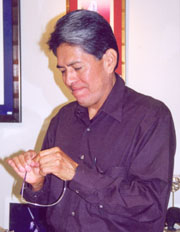Richard Chavez

The 1979 Collector’s Edition of Arizona Highways Magazine, featuring ” The New Look in Indian Jewelry,” named Richard Chavez, 29, a young jeweler “with his artistic life still ahead of him.” Richard’s work has always reflected his own expressions as an artist. Richard received immediate recognition for his jewelry, and his distinctive form, color and craftsmanship have kept him for 20 years at the fore front in changing the perception of what “Indian Jewelry” is supposed to be.
Although Richard was raised in a traditional Indian home in New Mexico, he was not deeply involved in the San Felepe Pueblo ways. Following High School, he briefly attended Fort Lewis College, Durango, Colorado, and Draughton’s Business college, Dallas, Texas. He returned to Albuquerque in 1971 where he was employed as an architectural draftsman for Harvey S. Hoshour, A.I.A. He remained in that position while he studied architecture at UNM from 1972 to 1975.
He began to make heishi under the direction of his grandfather. Around this same time, Richard realized his parents had dabbled in metal work when he found saws and other silversmith tools while clearing out their belongings. With increased interest, he bought a torch and began to teach himself metalwork techniques. He learned through experimentation. He learned that using the fine point of the torch was suitable for making small items like earrings but not large bracelets.
Richard Chavez work is almost Scandinavian in style – spare and flowing. He reaches beyond his San Felipe Pueblo heritage to grasp tomorrow’s promise. Bold, open shapes dominate his designs, yet a potent Indian flavor persists.His appreciation for simplicity and meticulous attention to detail evident in his jewelry-making grew out of his training as an architect. From his studies at the University of New Mexico, Chavez learned the concept of building outward. First, he creates the shapes of silver and gold before adding the stones.
Richard Chavez emphasizes clean lines in his elegant jewelry, which accents a minimal use of precious and semi-precious stones. He chooses to fabricate rather than cast the metal, and because he does his own lapidary work, he has control of the entire process.
In 1976 he won grand prize at the Eight Northern Pueblos Art and craft show. He continued to receive awards until he stopped entering competitions in 1990.
